Birds in Ouarzazate provide a wonderful diversity of species from around the world. The region is renowned for its natural beauty, and its bird population is an important part of this.
There are over 200 species of birds in Ouarzazate, ranging from the common Black Kite and the Brown-necked Raven to the more exotic Egyptian Vulture and the endangered Lesser Kestrel.
The variety of habitats, from mountains to deserts, allows for a wide variety of birds to be found. Some of Ouarzazate’s birds are migratory, meaning they travel from other parts of the world, while some are native to the region.
Ouarzazate is also home to several species of birds of prey, such as the Lanner Falcon and the Barbary Falcon. With so many species to be seen, birdwatching in Ouarzazate is a great way to experience nature and the region’s wildlife.
1. Bald Ibis
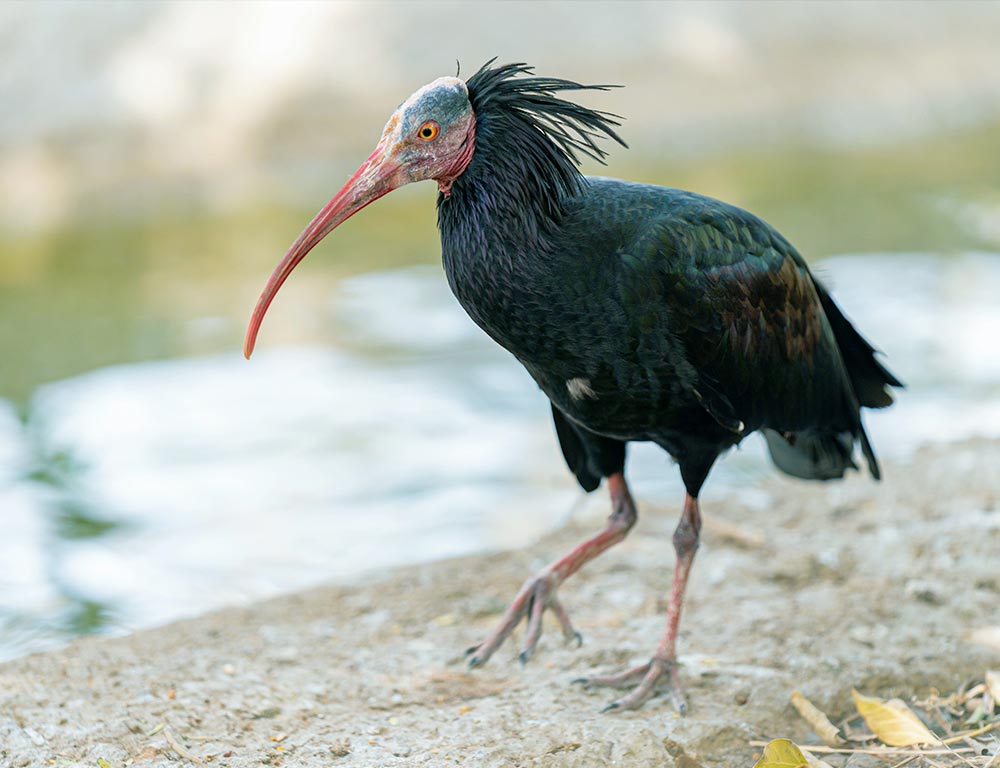
The northern bald ibis, also known as the hermit ibis or Waldrop is a migratory bird that inhabits barren, semi-desert, or rocky habitats, often close to running water. This striking species of ibis stands at a height of 70–80 cm and is glossy black in color.
Unlike many other members of the Ibis family, the northern bald ibis is a non-wading bird. The bird also has a distinctive appearance, with an unfeathered red face and head, and a long, curved red bill. The northern bald ibis has a long, complex migration pattern.
During the breeding season, it is found in dry regions of the Middle East and North Africa, while in the winter months, it migrates to Ethiopia and Somalia.
Unfortunately, its population is declining due to habitat destruction and hunting, and it is listed as an endangered species, with fewer than 1,000 individuals remaining in the wild.
Conservation efforts have been successful in recent years, however, and the species is slowly recovering.
| Kingdom | Animalia |
| Phylum | Chordata |
| Class | Aves |
| Order | Pelecaniformes |
| Family | Threskiornithidae |
| Genus | Geronticus |
| Species | G. eremita |
2. Ruddy Shelduck
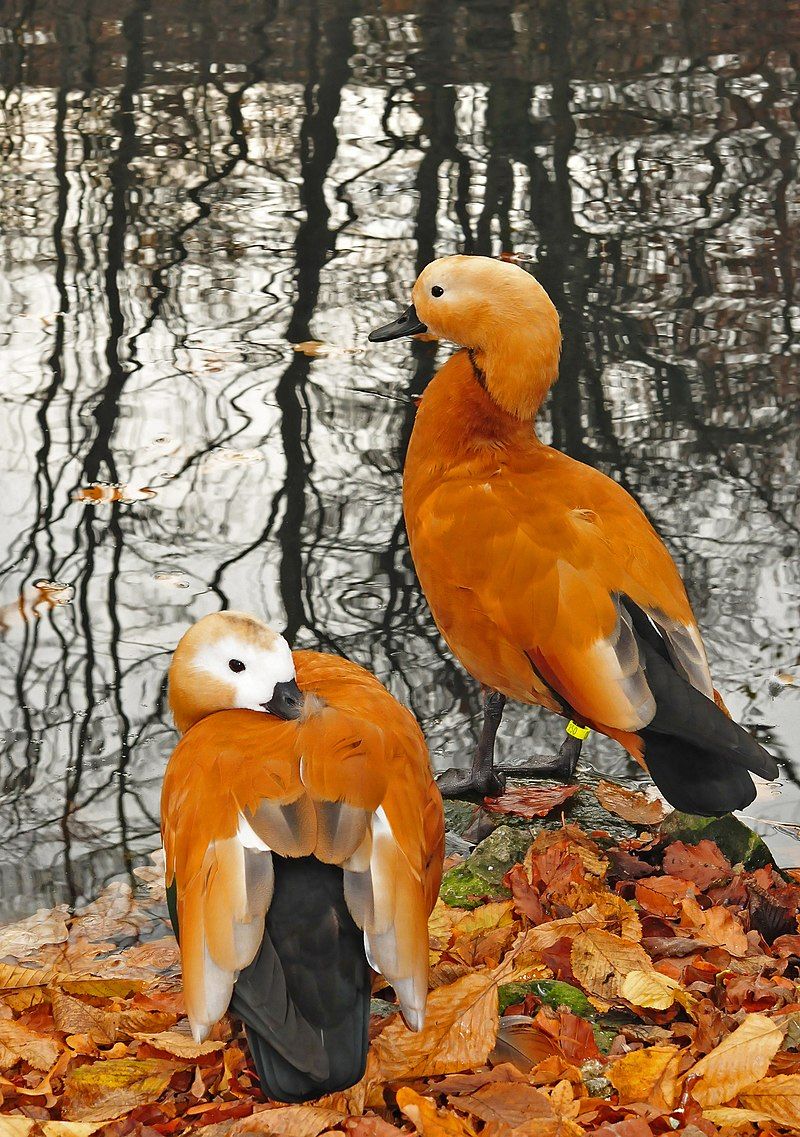
The ruddy shelduck, also known as the Brahminy duck, is a member of the family Anatidae, which includes waterfowl such as ducks, geese, and swans. It is a distinctive and easily identifiable species due to its size and color.
The ruddy shelduck typically grows to a length of between 58 and 70 cm, with a wingspan of 110 to 135 cm. Its body is predominantly a reddish-brown color, with a paler head and neck and a white patch on its wings, which can be seen when it is in flight.
The ruddy shelduck also has a unique call, which consists of a loud whistle followed by a series of quacks. This species can be found in wetland habitats, such as lakesides, marshes, and rivers, where it feeds on insects, seeds, and aquatic plants.
It is common throughout much of India, and is a popular game bird, with many people hunting it for sport.
| Kingdom | Animalia |
| Phylum | Chordata |
| Class | Aves |
| Order | Anseriformes |
| Family | Anatidae |
| Genus | Tadorna |
| Species | T. ferruginea |
3. Spotted Sandgrouse
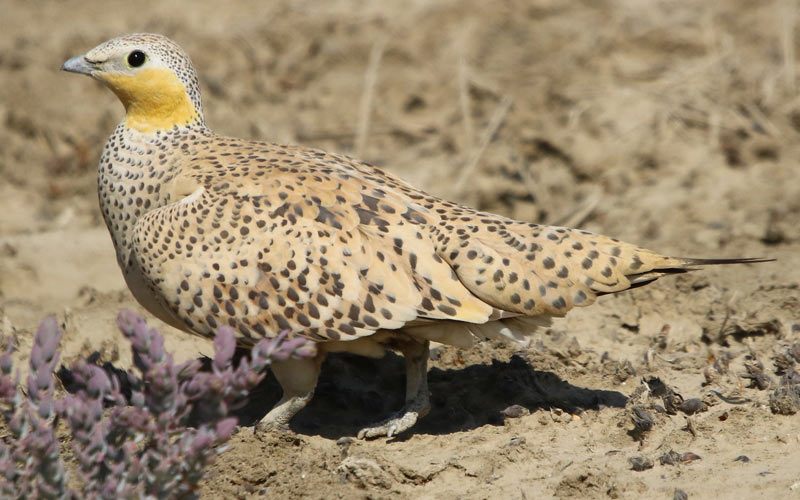
The Spotted Sandgrouse is a unique and interesting species of bird in the family Pteroclidae. It is found in arid regions of northern and eastern Africa, the Middle East, and parts of Asia. This includes northwest India, making it a species with a wide geographical range.
The spotted sandgrouse is a ground-dwelling bird, meaning that it lives on the ground, rather than in trees or on cliffs. Its habitat is typically dry and sandy, with sparse vegetation, and its diet consists of seeds, grains, and other plant matter.
The spotted sandgrouse’s long wings and strong legs allow it to cover large distances in search of food. It has adapted well to living in these arid and semi-desert environments and can cope with extreme temperatures and lack of water.
The bird also has an interesting feature to help it survive in its environment – its feathers are covered with a layer of white powder, which helps to keep the bird cool by reflecting the sun’s rays. The spotted sandgrouse is a social bird, and can often be seen in small flocks.
Its main predators are eagles and other large birds of prey, as well as foxes and other small mammals. The bird’s numbers have been decreasing in recent years due to the destruction of its habitat, as well as overhunting.
Conservation efforts have been put in place to help protect the species and preserve its numbers.
| Kingdom | Animalia |
| Phylum | Chordata |
| Class | Aves |
| Order | Pterocliformes |
| Family | Pteroclidae |
| Genus | Pterocles |
| Species | P. senegallus |
4. Crowned Sandgrouse
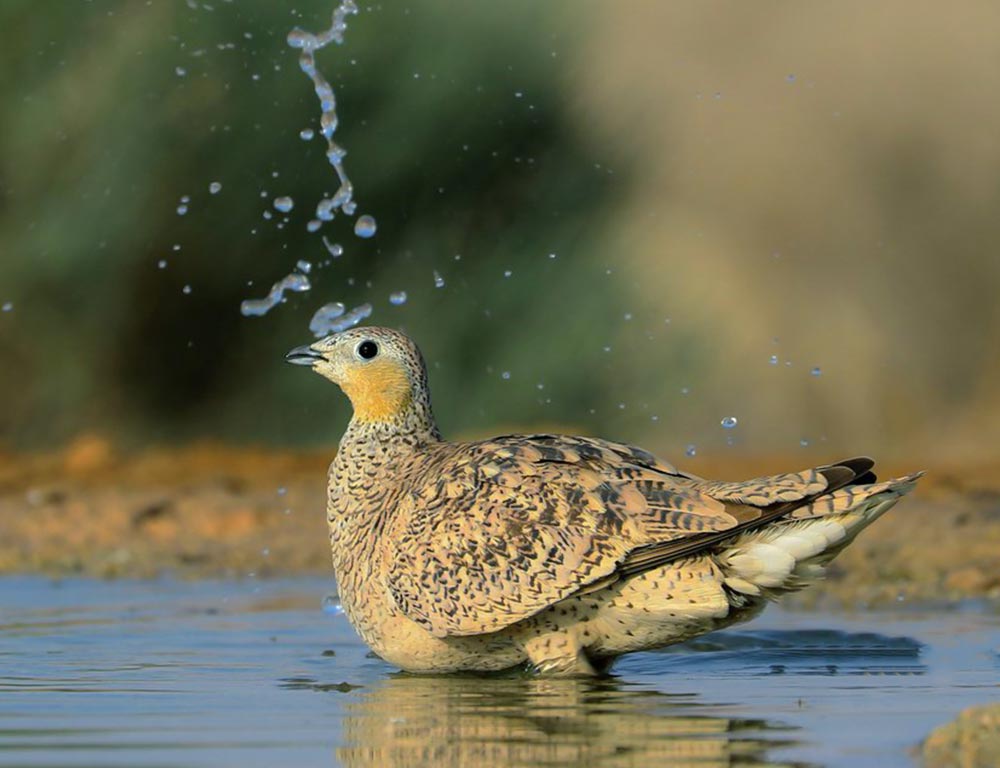
The crowned sandgrouse is a unique species of bird. It belongs to the sandgrouse family, which is scientifically known as the Pteroclidae. This bird is found in North Africa and the Middle East, and it is easily recognizable due to its distinctive crest.
The crowned sandgrouse is a medium-sized bird, with a wingspan of about 30 to 40 cm. Its feathers are predominantly sandy-colored, with some white spots on its wings and tail. Its head is crowned with a black crest, which is the source of its name.
The crowned sandgrouse is a ground-dwelling bird, often seen in dry, open country. It feeds mainly on grass and grain and can be seen in large flocks, often with other sandgrouse species.
This species has adapted well to the harsh desert conditions of its native habitat and is often seen in the same area year after year.
| Kingdom | Animalia |
| Phylum | Chordata |
| Class | Aves |
| Order | Pterocliformes |
| Family | Pteroclidae |
| Genus | Pterocles |
| Species | P. coronatus |
5. Moussier’s Redstart
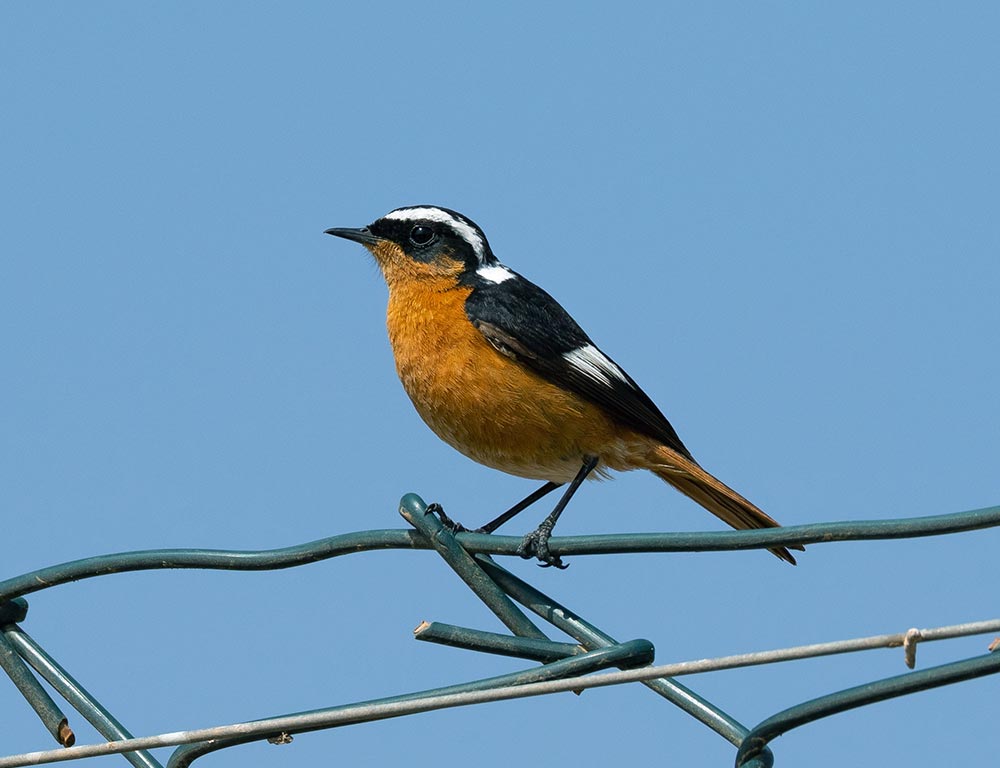
Moussier’s redstart is a species of small, passerine bird that belongs to the genus Phoenicurus. It was previously classified as a member of the thrush family but has since been reclassified as an Old World flycatcher.
This species is an endemic resident breeder, which means that it is native to and breeds exclusively in one specific region, in this case, the Atlas Mountains in northwest Africa. This species is not migratory and tends to remain in its chosen habitat throughout the year.
It can be found in open woodland and scrub where it feeds on insects, small invertebrates, and other small prey. It has striking black, white, and red plumage and is an interesting and attractive species of bird.
| Kingdom | Animalia |
| Phylum | Chordata |
| Class | Aves |
| Order | Passeriformes |
| Family | Muscicapidae |
| Genus | Phoenicurus |
| Species | P. moussieri |
6. Great Crested Grebe
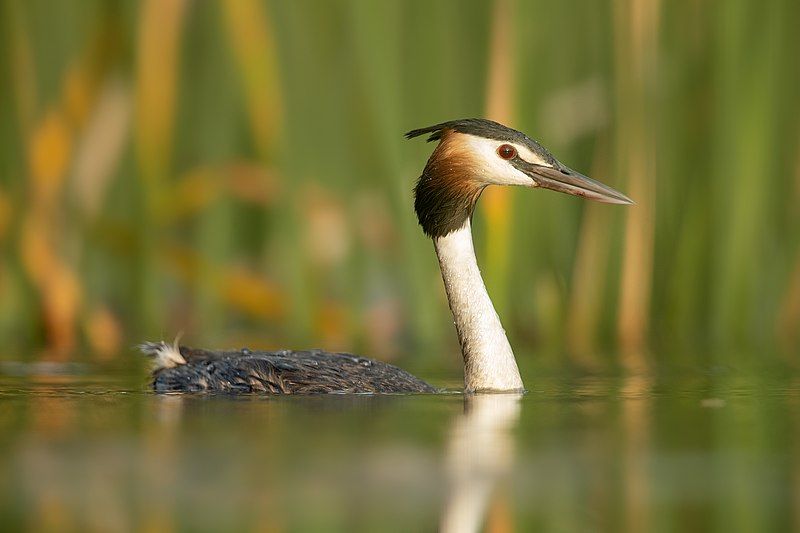
The great crested grebe is a species of water bird in the grebe family of birds. They are a migratory species found throughout much of the Northern Hemisphere.
These birds are known for their elaborate and beautiful mating displays during the breeding season. The great crested grebe is a medium-sized water bird and has distinctive black and white feathers. It has a long pointed bill and a neck that is chestnut in color.
The male and female have similar plumage, but the male has a more colorful head with a golden crest. During mating season, the male and female perform an elaborate courtship display.
This includes postures and movements where the birds bow, point their bills to the ground, and swim in circles. They will also make a whistling sound with their bill and rapidly shake their head.
This display is believed to be an attempt to impress the female and demonstrate the male’s strength and fitness. Once a pair has paired up, they will build a nest together. This is usually constructed from vegetation and built on the surface of the water.
The female will lay 2-5 eggs, which are incubated by both parents. The chicks are covered in black down and can swim shortly after hatching.
The parents will guard the nest and chicks for around 3 weeks until the chicks can fly. The great crested grebe is an interesting species of water bird that is well-known for its elaborate mating display.
These birds are found in a variety of habitats and can be seen throughout the Northern Hemisphere.
| Kingdom | Animalia |
| Phylum | Chordata |
| Class | Aves |
| Order | Podicipediformes |
| Family | Podicipedidae |
| Genus | Podiceps |
| Species | P. cristatus |
7. Sandgrouse
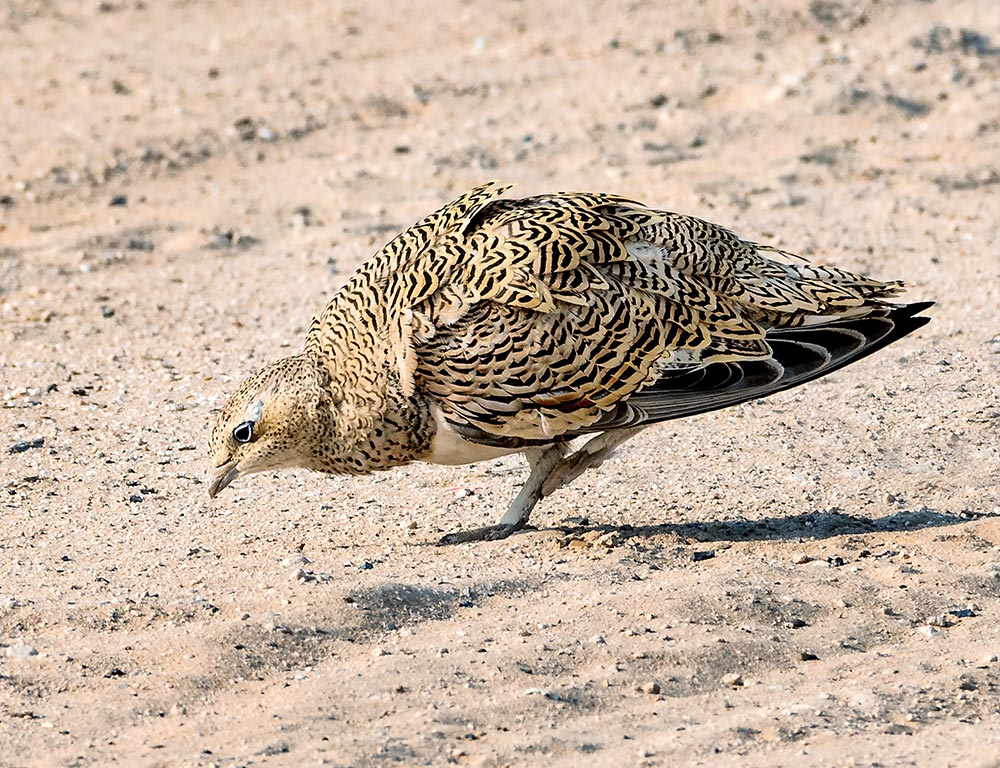
Sandgrouse are a family of birds, known as Pteroclidae, belonging to the order Pterocliformes. They consist of sixteen species and are generally divided into two genera.
The two central Asian species are classified as Syrrhaptes and the other fourteen species, which are found in Africa and Asia, are placed in the genus Pterocles. Sandgrouse are known for their ability to fly long distances.
They have powerful wings, which enable them to cover large distances in a short amount of time. Their feathers are also adapted to help them in this, as they are well-insulated so that they can conserve energy and remain hydrated during their long flights.
Sandgrouse are found in a variety of habitats, including desert, grassland, and savanna. They feed mainly on seeds and grains, which they can find in their habitats. They also eat other plant material, such as insects, worms, and berries.
Sandgrouse are social birds and are often seen in large flocks. They form strong bonds with other members of their flock and will defend their territory against intruders. They are also known for their unique mating displays, which involve both males and females.
Sandgrouse are an important part of the ecosystem, as they help to disperse seeds and maintain the balance of their environment. They are also popular game birds and are hunted for sport in some areas.
| Kingdom | Animalia |
| Phylum | Chordata |
| Class | Aves |
| Clade | Columbimorphae |
| Order | Pterocliformes |
| Family | Pteroclidae |
8. Western Yellow Wagtail
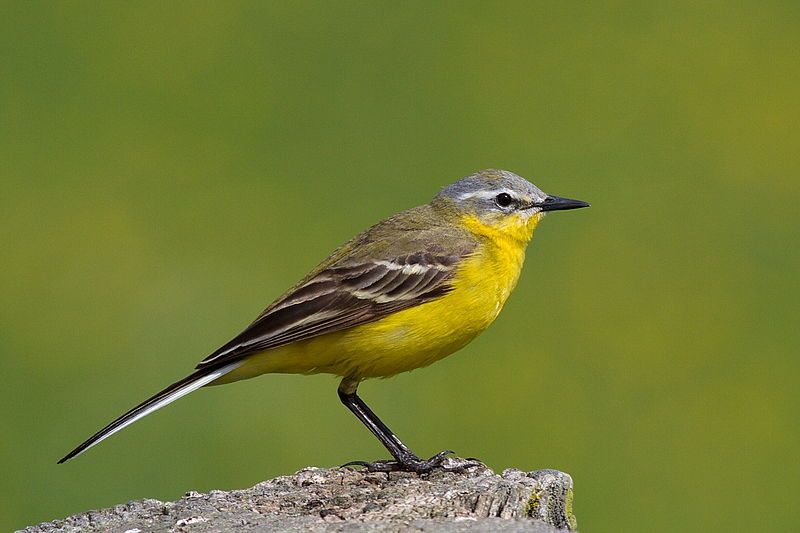
The western yellow wagtail is a small bird belonging to the family of Motacillidae, which is made up of other species such as pipits and longclaws. It is mainly found in temperate regions of Europe and Asia, where it breeds and raises its young.
This species of bird is typically characterized by its long tail, which can be used for balance and agility during flight. Its plumage is mainly yellow in color, though there are variations in the shade among different populations.
It is a very active bird, often foraging for food in open grassland or on the edges of fields and waterways. The western yellow wagtail is a valuable species in many ecosystems, providing insect control, pollination, and even aeration of soil.
This species is also important to the local culture, with its unique musical call often used as a symbol of good luck.
| Kingdom | Animalia |
| Phylum | Chordata |
| Class | Aves |
| Order | Passeriformes |
| Family | Motacillidae |
| Genus | Motacilla |
| Species | M. flava |
9. Trumpeter Finch
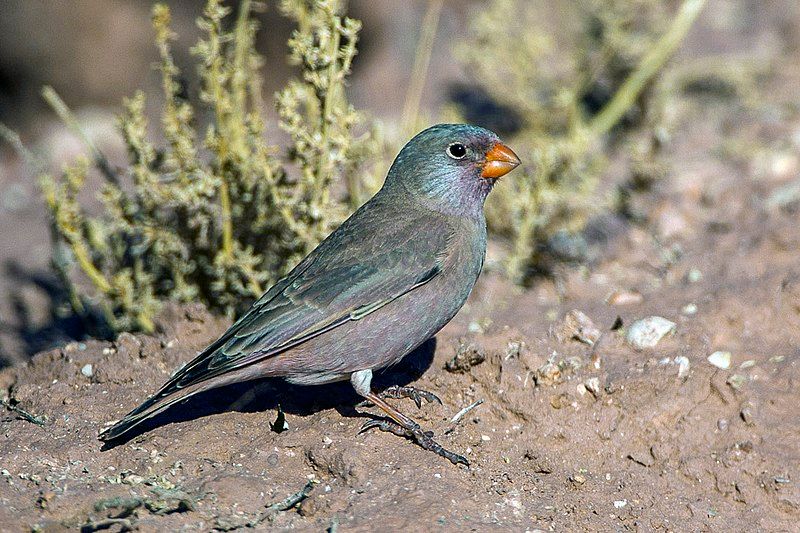
The trumpeter finch is a small bird that belongs to the Fringillidae family. It is native to many parts of the world, including North Africa, Spain, and southern Asia. It is mostly found in desert habitats and is known for its distinctive call.
This call is similar to the sound of a trumpet and is the source of its common name. The trumpeter finch is also known for its migratory habits and has been observed as a vagrant in parts of the world outside of its usual breeding range.
This includes areas north of its native range, such as Europe and the United States. The trumpeter finch is an important species in its native habitat and plays an integral role in maintaining the local ecosystem.
It is also an important food source for many predators, including hawks and owls.
| Kingdom | Animalia |
| Phylum | Chordata |
| Class | Aves |
| Order | Passeriformes |
| Family | Fringillidae |
| Genus | Bucanetes |
| Species | B. githagineus |
10. Glossy Ibis
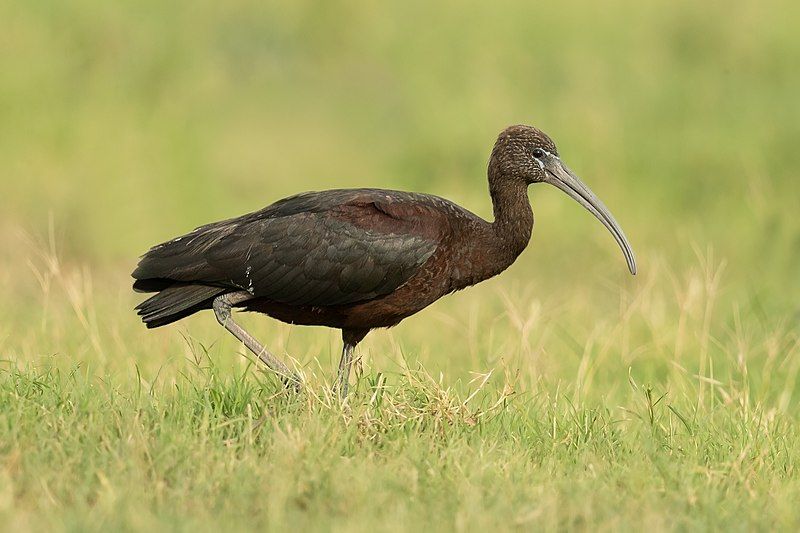
The glossy ibis is a type of water bird found in the Pelecaniformes order and is part of the Threskiornithidae ibis and spoonbill family. Its scientific name, derived from Ancient Greek and Latin, gives a clue to the shape of its distinctive bill.
‘Plegados’ and ‘falcis’ both translate to ‘sickle’, a term that is used to describe the curved shape of the glossy ibis’ bill. This curved beak helps the ibis to feed, as it allows them to sift through mud and shallow water in search of food, such as fish, insects, and worms.
The glossy ibis is a large bird, usually measuring between 25-30 inches in length, with a wingspan of up to 40 inches. It has a mainly brown plumage, with a dark, glossy head and neck, and bright red legs.
The glossy ibis is a widespread species, found in many parts of the world, including North America, Europe, Africa, and parts of Asia. It is often seen wading in shallow waters or perched on the edges of lakes and rivers.
| Kingdom | Animalia |
| Phylum | Chordata |
| Class | Aves |
| Order | Pelecaniformes |
| Family | Threskiornithidae |
| Genus | Plegadis |
| Species | P. falcinellus |
11. Red-crested Pochard
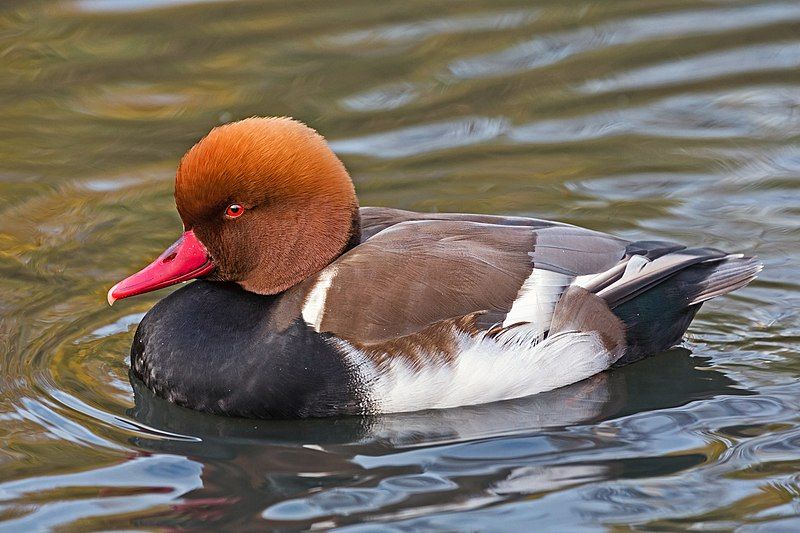
The red-crested pochard is a large diving duck found in many parts of the world. It is a member of the Anatidae family and is known for its distinctive red crest on its head and black body.
The scientific name for the red-crested pochard is Netta rufina, which is derived from the Greek word “Netta” meaning duck, and the Latin word “Rufina” meaning golden-red.
This species of duck is found in wetlands, rivers, lakes, and estuaries, and feeds primarily on aquatic plants and small fish. The red-crested pochard is an important member of many aquatic ecosystems and helps to keep habitats healthy and balanced.
It is also an important source of food for many other animals, including humans. The red-crested pochard is a beautiful and valuable species that deserves our protection and conservation.
| Kingdom | Animalia |
| Phylum | Chordata |
| Class | Aves |
| Order | Anseriformes |
| Family | Anatidae |
| Genus | Netta |
| Species | N. rufina |
12. Common Chiffchaff
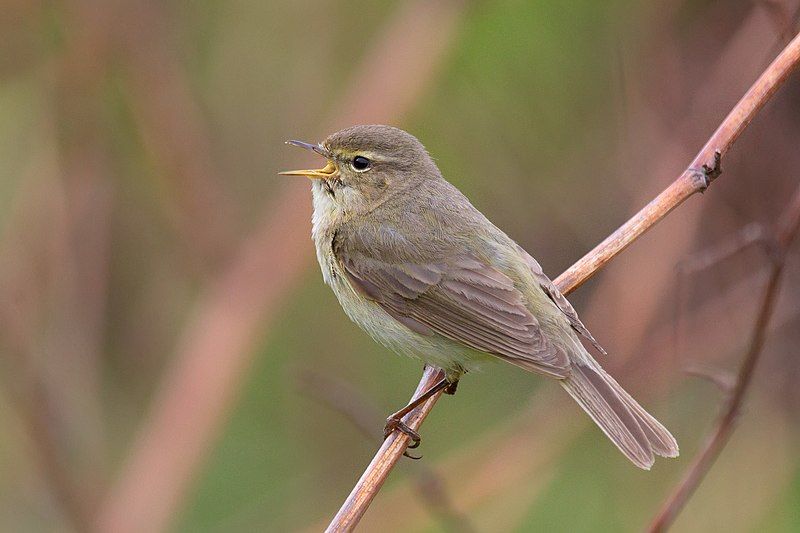
The common chiffchaff is a small migratory bird that is found in many parts of the world. It is a type of leaf warbler that is commonly found in open woodlands in Europe and the Palearctic.
This bird is known for its distinctive chirp, which is the source of its name. The common chiffchaff breeds during the spring and summer months in its northern and temperate range.
During the winter months, the chiffchaff migrates to warmer climates in southern and western Europe, southern Asia, and North Africa.
This bird can travel thousands of miles each year to access suitable breeding and wintering habitats. The common chiffchaff is an important part of the ecosystem as it helps to control insect pest populations.
It also plays a role in the pollination of plants and the dispersal of plant seeds. This bird is an important component of the food web and plays an important role in maintaining biodiversity. Overall, the common chiffchaff is a small, but important bird in the world.
Its migratory habits spread its influence to many different locations and it plays an important role in maintaining the balance of the ecosystem.
| Kingdom | Animalia |
| Phylum | Chordata |
| Class | Aves |
| Order | Passeriformes |
| Family | Phylloscopidae |
| Genus | Phylloscopus |
| Species | P. collybita |
Conclusion
The birds of Ouarzazate are an important part of the natural environment. They provide a vital source of food for many species, offer a great source of entertainment, and are an essential part of the local ecology.
As Ouarzazate continues to develop, the birds of Ouarzazate must be protected and respected to maintain a vibrant and diverse ecosystem.